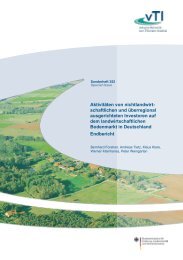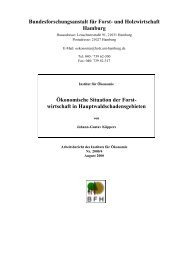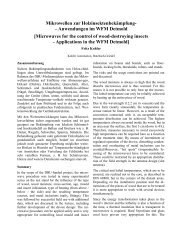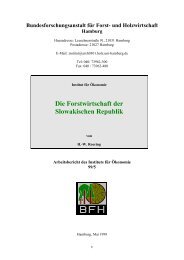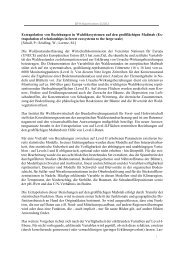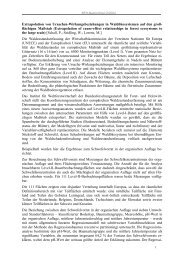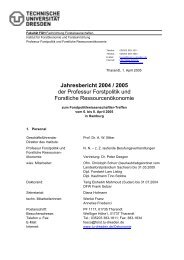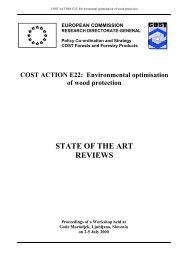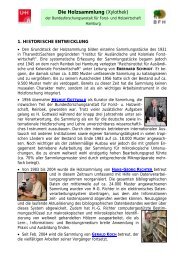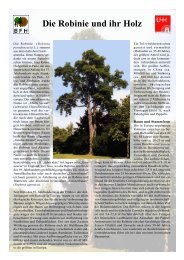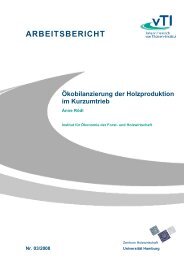Vegetative Propagation of Cupressus sempervirens
Vegetative Propagation of Cupressus sempervirens
Vegetative Propagation of Cupressus sempervirens
Create successful ePaper yourself
Turn your PDF publications into a flip-book with our unique Google optimized e-Paper software.
sense, WISE and CALDWELL (1992) stated that although hedging<br />
eliminates mature upper crowns that would produce cuttings<br />
with reduced rooting capacity, the resulting juvenile shoots<br />
may still be subject to seasonal fluctuations. The authors cite<br />
experiments with slash pine cuttings collected from hedged<br />
and nonhedged donors in which the results concerning the best<br />
time for cutting collection are contradictory.<br />
The preconditioning <strong>of</strong> the ortets in the present experiments<br />
is more comparable with the research by PANETSOS (1993) on<br />
<strong>Cupressus</strong> <strong>sempervirens</strong> where hedged donors were used. The<br />
results from his study showed that the cuttings collected in<br />
early summer rooted better than those from the spring<br />
collection. The advantage <strong>of</strong> late summer cutting collection as<br />
opposed to the early spring one was shown also for<br />
Chamaecyparis selected cultivars (OSIECKA, 1991).<br />
The results are further complicated by the presence <strong>of</strong><br />
genotype x season interaction. The genotype which rooted best<br />
during the winter, did not root at all in the spring experiment.<br />
At the same time, despite the mass drying <strong>of</strong> the cuttings<br />
during the spring experiment, one <strong>of</strong> the genotypes (G11) kept<br />
most <strong>of</strong> its cuttings alive without rooting. Since different<br />
prerequisites, such as high food reserves, C:N ratio, higher<br />
auxin levels to low cytokinins, and gibberellins have to be<br />
satisfied in order to achieve good rooting, it is logical that the<br />
optimal condition for each particular genotype will be reached<br />
at a different moment.<br />
Finally, it can be concluded that the time <strong>of</strong> year at which<br />
cuttings are collected is <strong>of</strong> key importance for the success <strong>of</strong><br />
rooting. However, the optimum season for rooting is more<br />
related to the physiological condition <strong>of</strong> the plant than to any<br />
given calendar date. In this sense, the environmental<br />
preconditioning <strong>of</strong> individual donor plants (an effect referred to<br />
as common or “C” effect) must also be considered when the<br />
experiments are performed and conclusions are drawn. The<br />
results from the present study and the recommendations <strong>of</strong> the<br />
other investigators imply that a new trial should be done with<br />
a late spring cutting collection from the same donor plants. It<br />
would verify the reasons for the poor rooting achieved during<br />
the spring and would clarify the best time for cuttings<br />
collection in the particular conditions.<br />
Preliminary rejuvenation <strong>of</strong> the donor plant<br />
Hedging has for long time been recognised as a method to<br />
maintain juvenility <strong>of</strong> plants. However, this technique seems to<br />
cause some physiological changes in the ortets (WISE and<br />
CALDWELL, 1992), adversely affecting the rooting (PANETSOS,<br />
unpublished).<br />
In the present study, the material from nonhedged donors<br />
showed significantly higher rooting percentage than the<br />
cuttings from the hedged ortets (15.87% vs. 1.85%). Despite<br />
this fact, firm conclusions can not be drawn about the advantages<br />
<strong>of</strong> nonhedged over hedged donors concerning the rooting<br />
rate, because the genotypes used from the 2 categories were<br />
not the same. However, the different morphological characteristics,<br />
the successive changes during the rooting, and the survival<br />
rate <strong>of</strong> the cuttings originated from the 2 type ortets, were<br />
striking. The cuttings from hedged donors were succulent, possessed<br />
characteristics <strong>of</strong> sun shoots and had fewer leaves. Soon<br />
after their insertion into the rooting medium they started drying<br />
from the top and at the end <strong>of</strong> the rooting period, there was<br />
75% mortality. The cuttings from the nonhedged donors had a<br />
higher number <strong>of</strong> dark-green leaves. Only 25% <strong>of</strong> the cuttings<br />
had dried at the end <strong>of</strong> the third month.<br />
Besides the effect <strong>of</strong> topophysis, ZOBEL and TALBERT (1984)<br />
recognised another cause <strong>of</strong> variation among the propagules<br />
obtained from a single donor plant and connected with their<br />
location on it. They called it periphysis, which refers to<br />
locations in different environments on an individual tree, such<br />
as shade and sun shoots. Even though the present rooting<br />
material was not obtained from the same plant, the shoots<br />
collected from the hedged donors could be classified as sun<br />
shoots and those from the nonhedged as shade shoots. In the<br />
present case, there were fast growing, succulent, low in<br />
carbohydrates shoots from hedged ortets on the one hand, and<br />
slowly growing, with high carbohydrate: nitrogen ratio shoots<br />
from nonhedged donors, on the other hand. As the nonhedged<br />
stock plants were positioned very closely, natural etiolation <strong>of</strong><br />
the basal part <strong>of</strong> the crown may also have played a role in<br />
enhancing adventitious root formation (CAPUANA and<br />
LAMBARDI, 1994). It could be concluded that the cuttings from<br />
hedged donors exhibit different growth patterns than those<br />
from the lower shaded part <strong>of</strong> the nonhedged donors. Although<br />
they are thought to be more juvenile in character, they<br />
appeared to be more susceptible to and more dependent on the<br />
environmental conditions. In this case, the risk <strong>of</strong> getting<br />
lower rooting percentage (from the non-rejuvenated donors) is<br />
more justified than the risk <strong>of</strong> losing the whole cutting<br />
material. However, the question <strong>of</strong> whether the cuttings from<br />
hedged donors possess higher rootability than those from the<br />
young lower third <strong>of</strong> nonhedged donors has not been answered.<br />
The fact that cuttings from hedged ortets rooted only when<br />
treated with the higher IBA concentration casts doubt on the<br />
subject. Therefore, an experiment should be conducted with<br />
rooting material from the same genotypes but coming from<br />
both rejuvenated and nonrejuvenated ramets.<br />
Acknowledgments<br />
We are grateful to the Mediterranean Agronomic Institute <strong>of</strong> Chania<br />
where this research was conducted with the financial support <strong>of</strong> the EU<br />
Contract No AIR 3-CT 93-1675.<br />
References<br />
BLYTHE, G.: Cutting propagation <strong>of</strong> <strong>Cupressus</strong> and x Cupressocyparis.<br />
The International Plant Propagators’ Society Combined Proceedings 39:<br />
154 – 160 (1989). — BROWSE, P. M.: Plant propagation. Mitchell Beazley,<br />
London (1985). — CAPUANA, M. and LAMBARDI, M.: Cutting propagation<br />
<strong>of</strong> common cypress (<strong>Cupressus</strong> <strong>sempervirens</strong> L.). New Forests 9(2): 111 –<br />
123 (1994). — CHEMLA, M.: <strong>Vegetative</strong> propagation <strong>of</strong> cypress (<strong>Cupressus</strong><br />
<strong>sempervirens</strong> L.) by cuttings. M.Sc. thesis. Hebrew Univ. <strong>of</strong> Jerusalem<br />
(Summary) (1986). — COUVILLON, G. A.: Rooting responses to different<br />
treatments. Acta Horticulturae 227: 187 – 196 (1988). —<br />
DAOUST, G., BEAULIEU, J. and CORRIVEAU, A.: Rooting abilities <strong>of</strong> cuttings<br />
from sexually mature Norway spruce. Information report. Laurenian<br />
Forestry Centre, Canadian Forestry Service (1987). — HARTMANN, H. T.<br />
and KESTER, E. D.: Plant propagation. Principles and practices. Fourth<br />
edition. Prentice-Hall, Inc., Englewood Cliffs, New Jersey (1983). —<br />
HENRY, P. H., BLAZICH, F. A. and HINESLELY, L. A.: <strong>Vegetative</strong> propagation<br />
<strong>of</strong> eastern red cedar by stem cuttings. Hort Science 27(12): 1272 –<br />
1274 (1992). — JOHNSEN, Q.: Rooting <strong>of</strong> juvenile succulent cuttings from<br />
half-sib families <strong>of</strong> Picea abies. Scand. J. For. Res. 1: 27 – 36 (1986). —<br />
JORDANOV, S.: Seed and vegetative propagation <strong>of</strong> Arisona and Italian<br />
cypresses. Higher Forestry Institute. Scientific papers, volume XXXV.<br />
Zemizdat, S<strong>of</strong>ia (1992). — KIDOH, H., TAKIKAWA, S. and UJIIE, M.: Rooting<br />
<strong>of</strong> hiba (Thujopsis dolobrata var. hondai) cuttings in different cultural<br />
beds and the growth <strong>of</strong> their rooted cuttings in a plantation. Journal<br />
<strong>of</strong> Japanese Forestry Society 71(5): 200 – 203 (1989). — LAMB KELLY<br />
and BOWBRICK: Nursery stock manual. Grower Books, London (1985). —<br />
LORENZI, R. and CECCARELLI, N.: Viviasmo e propagazione per talea in<br />
relazione al ciclo vegetativo: Picea abies pungens kosteriana glauca e<br />
<strong>Cupressus</strong> <strong>sempervirens</strong>. Riv. Ort<strong>of</strong>lor<strong>of</strong>rutt. It. 65: 11 – 20 (1981). —<br />
OSIECKA, A.: All-year-round propagation <strong>of</strong> Chamaecyparis pisifera ‘Plumosa<br />
Aurea’ by cuttings. Rosliny ozdobne. Prace instytutu sadownicstwa<br />
i kwiaciarstwa Seria B, Tom 16: 91 – 97 (1991). — PANETSOS, K. P.:<br />
<strong>Vegetative</strong> propagation <strong>of</strong> <strong>Cupressus</strong> <strong>sempervirens</strong> L. by s<strong>of</strong>twood stem<br />
cuttings. Presentation at the annual meeting <strong>of</strong> the participants for the<br />
CT 90 0005 EC project in Lisbon. (1993). — PANETSOS, K. P., ZARAGOTAS<br />
D. A. and SCALTSOYIANNES, A.: Macropropagation <strong>of</strong> Greek fir by s<strong>of</strong>twood<br />
stem cuttings. International workshop “Mediterranean firs. Adap-<br />
143



